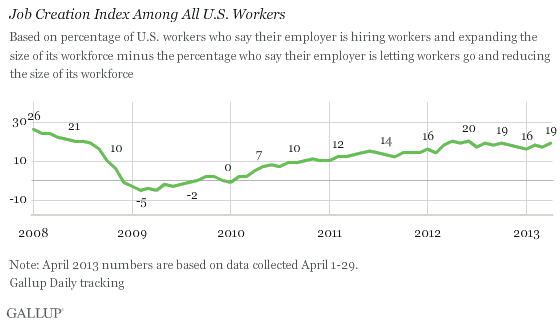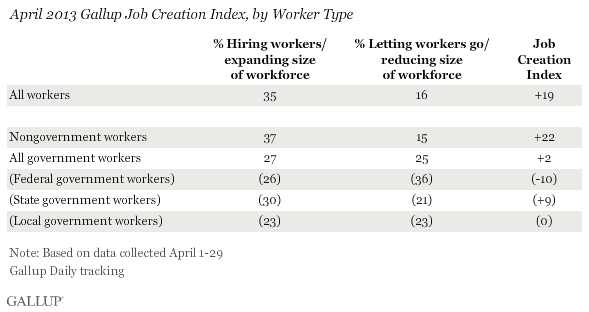WASHINGTON, D.C. -- Gallup's U.S. Job Creation Index was +19 in April, near the top of the narrow range found since March 2012, and higher than levels seen from 2009 through 2011.

The index score for April is based on 35% of U.S. workers telling Gallup that their employer is hiring new people and expanding the size of its workforce and 16% saying their company is letting people go and reducing the size of its workforce. The Job Creation Index has been consistently in positive territory since February 2010, improving steadily since that time, but is still not as strong as it was in early 2008, before the financial collapse.
Reports of Job Cuts Ease at Federal Government Level
The Job Creation Index score among federal workers improved to -10 last month after dropping to -18 in March, following the federal budget sequester that took effect on March 1. The score for federal workers is now back in the general range recorded in January and through most of 2012.

This improvement in the index for federal workers reflects a drop in the percentage of federal government workers reporting that their employer is letting people go to 36% in April, after it rose to 41% in March. However, the 26% of federal workers who said the government is hiring in April is similar to the 23% who said so in March.
It is unclear whether the uptick in federal government workers' reports of job cuts in March partly reflected a psychological reaction to the news of the sequestration cuts. And now that they have been in effect for some time, federal workers are getting a better sense of the reality of the jobs situation.
The net improvement in the Job Creation Index among federal workers -- as well as among state government workers -- brought the score among all government workers back into positive territory in April, at +2. In March, the score for all workers had turned negative for the first time since July.
Despite the recent shifts, the Job Creation Index score among state and local government workers continues to be higher than what it is among their federal counterparts, as it has been for some time.

Job creation though is strongest among nongovernment workers, rising to +22 last month from +20 in March. This is based on 37% saying their companies are hiring and 15% saying they are letting people go.
Nongovernment workers represent the vast majority of U.S. workers, which is why the overall Job Creation Index of +19 is much closer to the nongovernment score of +22 than the government workers score of +2.
Bottom Line
Job creation, according to American workers' reports, remains much better this year that it was in 2009, 2010, and 2011. But, reports of hiring have been stuck in the low to mid-30% range for some time. This is partly due to lower levels of government hiring. Nongovernment workers continue to report slightly higher levels of hiring.
The uptick in federal government workers' perceptions that their employers are letting people go does appear to have dissipated to some degree in April after increasing significantly in March -- although perceptions of hiring remain unchanged.
Gallup.com reports results from these indexes in daily, weekly, and monthly averages and in Gallup.com stories. Complete trend data are always available to view and export in the following charts:
Daily: Employment, Economic Confidence, Job Creation, Consumer Spending
Weekly: Employment, Economic Confidence, Job Creation, Consumer Spending
Read more about Gallup's economic measures.
View our economic release schedule.
Survey Methods
Results are based on telephone interviews conducted as part of Gallup Daily tracking April 1-29, 2013, with a random sample of 17,269 adults, aged 18 and older, employed full or part time, living in all 50 U.S. states and the District of Columbia.
For results based on the total sample of employed adults, one can say with 95% confidence that the margin of sampling error is ±1 percentage point.
Interviews are conducted with respondents on landline telephones and cellular phones, with interviews conducted in Spanish for respondents who are primarily Spanish-speaking. Each sample of national adults includes a minimum quota of 50% cellphone respondents and 50% landline respondents, with additional minimum quotas by region. Landline telephone numbers are chosen at random among listed telephone numbers. Cellphone numbers are selected using random digit dial methods. Landline respondents are chosen at random within each household on the basis of which member had the most recent birthday.
Samples are weighted to correct for unequal selection probability, nonresponse, and double coverage of landline and cell users in the two sampling frames. They are also weighted to match the national demographics of gender, age, race, Hispanic ethnicity, education, region, population density, and phone status (cellphone only/landline only/both, cellphone mostly, and having an unlisted landline number). Demographic weighting targets are based on the March 2012 Current Population Survey figures for the aged 18 and older U.S. population. Phone status targets are based on the July-December 2011 National Health Interview Survey. Population density targets are based on the 2010 census. All reported margins of sampling error include the computed design effects for weighting.
In addition to sampling error, question wording and practical difficulties in conducting surveys can introduce error or bias into the findings of public opinion polls.
For more details on Gallup's polling methodology, visit www.gallup.com.
